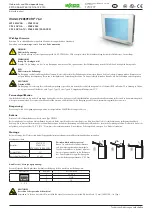
mn100 Analog Display
2
1 - Information
1.1 Introduction
Your Micronet instrument is powered for life by the environment.
Although feature packed and highly visible in all conditions, current
demand is so low, and the supply so efficient, that the solar-powered
display is self sufficient. Combined with other instruments in the
Micronet range this display becomes part of a complete navigational
system.
1.2 Specifications
Height of digits:
7mm (0.28”)
Backlighting:
3 levels with daylight shutoff
System-wide or local control
Power: Solar
Powered
300 hrs autonomy by day, 7 nights at brightest
backlighting, 20 nights at economy backlighting
without
charge
Units of display:
Wind Speed
(knots, meters per second, Beaufort)
Alarm:
Audible Alarm for Wind
Weight: 285g
(0.63lbs)
Operating Temp.: -100 to +600C (140 to 1400F)
Frequency:
868 MHz or 905 MHz
1.3
Power Management and Battery Life
What makes your mn100 instrument possible is Tacktick’s
revolutionary approach to power management. By reducing the
amount of power being used by the electronics and maximizing the
potential of the sun to provide power, a mn100 instrument becomes a
virtually perpetual device.
Power status is indicated by two icons on the instrument display:
Battery Level and
Charge Rate
Used together these icons will show the condition of your instrument’s
power supply.
Maintenance and Calibration
23
6.2.3 A single instrument flashes the battery symbol and then
switches off.
The battery level is low on the particular instrument affected. Connect
to a 9 to 24V power source or leave in bright sunlight for 12 hours
minimum to fully recharge the instrument’s internal battery. If the
particular instrument is the system Master* then the other instruments
will sound the Lost Network Alarm. To continue using the rest of the
system power down and restart the system from another instrument.
6.2.4 Low Battery Alarm Sounds.
The power level is low in the Hull Transmitter, NMEA Interface or Wind
Transmitter. On any Digital Instrument enter setup and calibration
mode (page 14) and scroll through to the Health Chapter.
Check the signal levels of the Transmitters and Interface Box. Connect
the Hull Transmitter or NMEA Interface to a 9 to 24V power source for
12 hours minimum to recharge the internal battery. Leave the Wind
transmitter in bright sunlight for 12 hours minimum to recharge its
internal battery.
6.2.5 Data is shown as dashes.
The information is not been transmitted to the instrument displays.
There may be lost communication between the Wind Transmitter or
Hull transmitter and the instrument displays. On any Digital instrument
enter setup and calibration mode (page 14) and scroll through to the
Health Chapter. Check the signal levels of the Hull and Wind
Transmitters
6.2.6 Wind speed reads 0.
Information being transmitted from the Wind Transmitter is being
received with a Zero value. If the anemometer cups at the top of the
mast are turning and the Wind Speed reads 0 then there is a problem
with your Wind Transmitter.
6.2.7 No NMEA data showing on external instruments.
From any Instrument enter setup and calibration mode (page 14) and
scroll through to the Health Chapter. Check the signal level and battery
status of the NMEA Interface Box.
*
The “Master Instrument” is the instrument which was used to power up
the entire system. This instrument may be different each time the
system is used. If you are fault finding and are uncertain which
instrument is the master the switch off the system and switch on again.
The instrument which you switched on is now the master


































